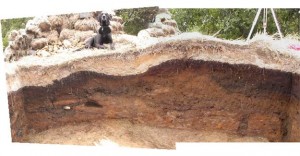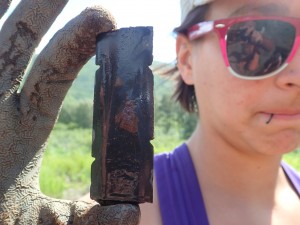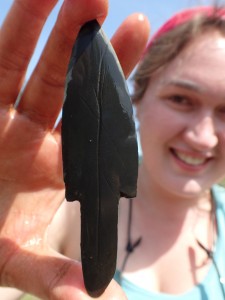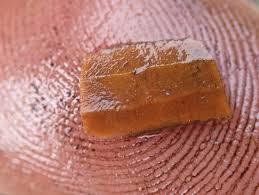Rachel Gill back with you again for just a glimpse into the vast Alutiiq history and how our small site fits into that enormous block of time…Okay, so maybe this won’t be a history of all time, but archaeologists have literally dug into almost 8,000 years of obvious human occupation on Kodiak using both stratigraphy and artifact recovery.
A (brief) vocabulary lesson:
The recovery of certain types of artifacts can tell a seasoned investigator what time period they come from and can lead to certain conclusions about household behavior, hunting techniques, or even diet. The word stratigraphy may only be familiar to you if you are an archaeologist or a geologist. At its most basic, it refers to the order and position of the layers of dirt we dig through. These layers can indicate certain time periods of occupation, can offer a way to date artifacts above or below a certain date-able layer, or they can even indicate specific activities.
 Example of the stratigraphy found at Salonie Creek, Kodiak Island – note the thick 1912 Katmai volcanic ash at the top, covering the archaeological layers below.
Example of the stratigraphy found at Salonie Creek, Kodiak Island – note the thick 1912 Katmai volcanic ash at the top, covering the archaeological layers below.
Some layers can be easily distinguished from one another, but sometimes it takes much more skill and practice to be able to tell the two thinly divided sediments apart. In Women’s Bay on Kodiak, each layer has its own name and defining characteristics, and many of these layers are common across nearly all sites. For example, the Katmai ash that blanketed the region in 1912 after the eruption of Novarupta. Those layers that are unique to the site itself would be the floor of a house or a fire pit. During our excavation, each layers has received a designation – L1, L2, L3, etc. (The ‘L’ in this case stands for, you guessed it, “level”. Please hold in your surprise!)
Alutiiq culture history:
The Kashevaroff site is just one of many around Women’s Bay on Kodiak Island, and we hope it will shed light on what life was like around the Bay. At the Kashevaroff Site, we uncovered the sod and the Katmai ash, and found L1 below. The top of L1 is dark brown sediment, and seems to contain Koniag-era artifacts. The Koniag period is thought to be from around 200 to 650 years ago. Typically, houses are multi-roomed and are frequently found on salmon streams, and they yield salmon harpoons carved from bone and ground slate ulus, or fish knives. Very few of the artifacts we have found at our site have been from this period, so the occupation must have been brief.
 Bayonet shaft used for hunting sea mammals – this is made of ground slate, which is common in the area around the Kashevaroff site.
Bayonet shaft used for hunting sea mammals – this is made of ground slate, which is common in the area around the Kashevaroff site.
Deeper in the site, into the bottom of L1, we are finding evidence of the earlier Kachemak phase. This phase is much broader, from 650 to nearly 4000 years ago. Circular houses were built from sod (bricks of soil, grass, ash, and roots dug up from the ground’s surface), making their walls easy to spot and excavate. On the floor of the house, archaeologists will typically find a central hearth for cooking, ground slate for making sharp projectile points, and stone net-sinkers…and we have begun to find evidence of these artifacts.
 Ground slate point – the lines may be the hunter’s identifying mark!
Ground slate point – the lines may be the hunter’s identifying mark!
Though we have not found any, in sites with better organic preservation archaeologists might find carved bone tools for hunting sea mammals and wooden artifacts used for decoration. Unfortunately, these poorly preserved artifacts are only found where the acidity of the volcanic ash falls (like the dark brown, weathered ash we found in L2) is balanced with basic materials, like decomposing clam shells. So far in our excavation, the Kachemak period has yielded red chert (a kind of stone that comes from the west side of Kodiak Island and is good for making chipped stone tools) and ground slate for making points. We’ve also uncovered a few beautiful points and tools themselves.
 Red chert stone tool from the Kachemak period – this is probably a small knife that would have been hafted into a bone handle.
Red chert stone tool from the Kachemak period – this is probably a small knife that would have been hafted into a bone handle.
As we move further down in the stratigraphy, L2 is what we like to call a “dead zone” because it is incredibly rare to find artifacts in this reddish brown ash fall. This is because it is just that: an ash fall that has been dated to about 3800 years ago and must have smothered the site when it fell. We can use this ash to help date the occupation at our site.
The really old stuff is in L3. This level contains artifacts dating anywhere from 3800 years ago (before the ash fell) to 7,500 BP, when the Ocean Bay period started. Ocean Bay I and II are the earliest occupations of Kodiak, and are characterized by slate and chipped stone tools and evidence of more ephemeral housing: rock rings to hold down tent covers and small post holes. We may find stone oil lamps for light and the house floors are often marked by red ochre stains, a pigment ground from naturally occurring mineral. These earliest occupants hunted a vast array of marine life and most times, Ocean Bay sites are located very near to the coast line. The most distinctive tool type found in this time period is called a microblade, so once you find of these small hunting tools, you know exactly where you stand in the timeline. These microblades were inserted into a wooden lance and used for hunting. As of now, we haven’t uncovered any obvious Ocean Bay artifacts, but the dig is still young and we have our fingers crossed.
 Example of a microblade from the Ocean Bay I period
Example of a microblade from the Ocean Bay I period
Hopefully our small site will shed a little more light on this complex and involved history by offering information about the earlier periods of the Alutiiq world.
I love it – you got Roxy Dog on top of the profile!
Patrick